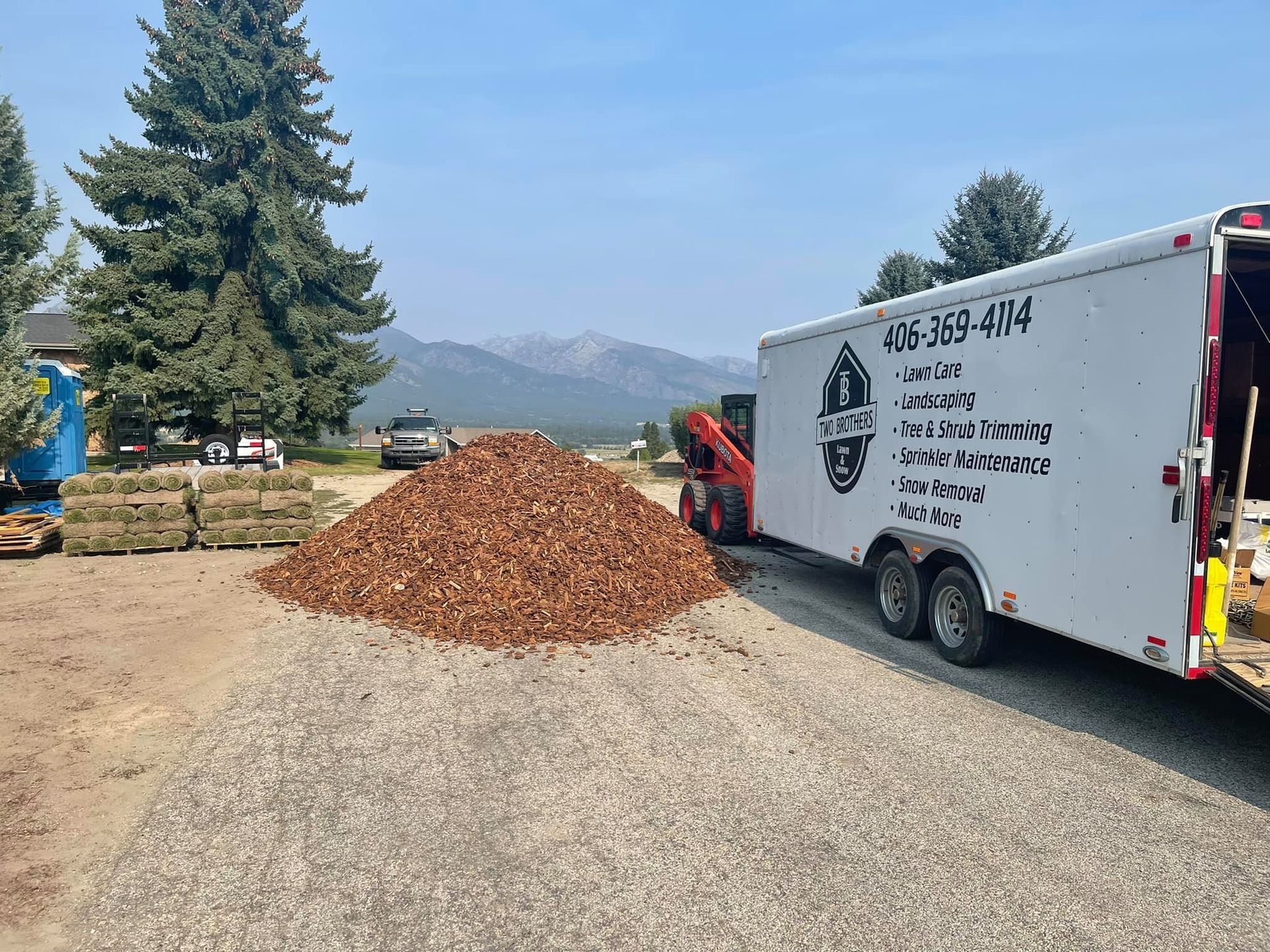
Table of Contents
- Understanding How Montana Winters Affect Lawns
- Steps for Successful Lawn Winter Preparation
- Aeration and Soil Health
- Fertilizing for Stronger Roots
- The Last Mow Before the Snow
- Cleaning Up Leaves and Debris
- Overseeding to Boost Spring Growth
- Practical Fall Lawn Care Tips from Local Pros
- Essential Yard Maintenance to Prevent Winter Damage
- Preparing Lawn Equipment for the Off-Season
- Why Consistent Preparation Pays Off Long-Term
- Work with Two Brothers Lawn and Snow, LLC
Key Takeaways
- Our unpredictable Montana winters demand thorough lawn winter preparation to protect grass health.
- Late-season aeration, fertilizing, and cleanup prevent root damage and snow mold.
- Following proper fall lawn care steps ensures faster green-up in spring.
- Consistent yard maintenance helps lawns resist disease, ice damage, and soil compaction.
Understanding How Montana Winters Affect Lawns
If there’s one thing we’ve learned after years of maintaining lawns across Montana, it’s that winter always finds a way to test your preparation. The long freezes, heavy snow, and unpredictable thaws can undo months of good summer growth if your yard isn’t ready.
We often tell homeowners that lawn winter preparation isn’t just about keeping things tidy—it’s about setting your grass up to survive months of stress. When the soil freezes, roots can’t absorb water or nutrients. Meanwhile, the weight of snow and ice compresses the ground, making it harder for oxygen to circulate. Add in fungal risks like snow mold, and you can see why so many lawns struggle to bounce back in spring.
The good news? A few smart, timely steps in the fall lawn care season can make all the difference. When you prepare your yard properly, you’re not just helping it survive winter—you’re helping it thrive next season.
Steps for Successful Lawn Winter Preparation
We always encourage our clients to start early, usually around late September or early October. The goal is to strengthen your lawn before the ground freezes and the first snow hits. Here’s how we approach lawn winter preparation for our Montana clients.
Aeration and Soil Health
Think of aeration as giving your lawn a deep breath before winter. During summer, soil naturally compacts from foot traffic, mowing, and rainfall. Compacted soil makes it tough for water, air, and nutrients to reach the roots.
By aerating in the fall, we open up those channels again. The small plugs of soil we remove allow oxygen and moisture to move freely. This helps roots grow deeper and stronger before dormancy sets in.
In our experience, this step alone can dramatically improve how well a lawn recovers in spring. It’s also the perfect time to combine aeration with overseeding or fertilizing, since the open soil allows new seed and nutrients to penetrate more effectively.
Fertilizing for Stronger Roots
Montana’s fall months create a sweet spot for feeding your lawn. The grass blades may be slowing their growth, but underground, the roots are still busy storing energy for winter. A slow-release fertilizer rich in nitrogen and potassium gives your turf what it needs to stay healthy through the cold months.
We like to think of this step as your lawn’s “winter meal.” Without it, grass roots go into dormancy weak, making them more vulnerable to disease, frost, and spring thinning. When done right, fall lawn care fertilization sets the stage for a thicker, greener comeback once temperatures rise.
If you’ve ever noticed your lawn looking patchy or dull after winter, odds are it didn’t get enough nutrients in the fall. A professional-grade fertilizer, applied at the right time and rate, can change that story completely.
The Last Mow Before the Snow
We get asked this one all the time: “When should I stop mowing?” Our rule of thumb is to keep mowing until your grass stops growing, but gradually lower your mower height each time toward the end of the season.
Leaving grass too long before winter can cause it to bend, mat, and trap moisture, which invites mold. Cutting it too short, though, can expose roots to freezing temperatures. That’s why the final mow—usually around 2 to 2.5 inches—is crucial.
This balanced height helps the lawn breathe while minimizing disease risk. It’s a small detail that can prevent big problems later.
Cleaning Up Leaves and Debris
It’s tempting to let fallen leaves blanket your yard in autumn, especially when you’re tired of raking. But that layer, once wet or frozen, quickly suffocates grass. It blocks sunlight and traps moisture, creating the perfect breeding ground for fungus.
We’ve seen lawns in Missoula and Bozeman turn patchy and moldy by spring simply because of uncollected leaves. That’s why we make leaf removal a key part of every yard maintenance plan we offer before winter.
You don’t need to clear every single leaf immediately—mulching some into the grass can add nutrients—but make sure thick piles are gone before snow arrives. Your grass will thank you in April.
Overseeding to Boost Spring Growth
If your lawn has bare spots or thinning areas, early fall is the best time to overseed. The soil is still warm enough for germination, and cool nights help seedlings establish without summer heat stress.
Overseeding after aeration works beautifully since the seed falls directly into those small holes, creating ideal contact with the soil. This process thickens your turf and helps crowd out spring weeds naturally.
In a place like Montana, where winters can be unpredictable, thicker grass coverage offers better insulation for the soil and roots. It’s one of the smartest investments you can make in your lawn’s future.
Practical Fall Lawn Care Tips from Local Pros
After years of working on lawns from Helena to Kalispell, we’ve seen what works—and what doesn’t—when it comes to fall lawn care. One of our best tips is to stay consistent with watering up until the ground freezes. Many homeowners assume rain or frost is enough, but grass roots still need moisture before dormancy.
We also recommend paying attention to timing. Don’t fertilize too early or too late—too early, and it promotes blade growth instead of root strength; too late, and the nutrients won’t absorb before the soil hardens.
Another common oversight? Ignoring shady areas. Lawns that get less sunlight in fall often stay wetter longer, increasing the risk of mold and rot. If you have shaded zones, keep them raked, aerated, and mowed slightly higher to prevent suffocation.
Most importantly, be patient. You won’t see the immediate payoff of your lawn winter preparation now, but you’ll notice it first thing in spring when your grass greens up faster than the neighbor’s.
Essential Yard Maintenance to Prevent Winter Damage
Montana winters can throw just about everything at your lawn—snow, ice, wind, and even freeze-thaw cycles that stress roots. The best way to protect against all of that is regular, thoughtful yard maintenance in the fall.
Inspect your yard for low areas where water tends to pool. Those spots can freeze solid and damage roots beneath. Fill them in with topsoil or compost to help water drain evenly.
If you’re unsure how to address drainage or lawn health issues, it may be time to recognize the signs you need professional landscaping help. Expert support can save you from costly damage down the line.
If you have trees or shrubs, trim back any branches that hang over the lawn. Snow and ice accumulation can snap branches, crushing the grass beneath them.
Finally, store away garden hoses, sprinklers, and decorations before snow arrives. Frozen hoses can crack and leak in spring, while left-behind items create dead patches on your grass.
We treat every lawn as if it were our own, and these small tasks make a noticeable difference come March and April.
Preparing Lawn Equipment for the Off-Season
While the focus is usually on the grass, don’t forget about your tools. Before you pack your mower away, clean off any grass clippings, sharpen the blades, and change the oil if needed. A dull blade tears grass instead of cutting it, leaving ragged edges that invite disease.
If you use a snowblower, this is also the time to check belts, fuel, and oil so you’re not stuck mid-storm. We always say that a well-prepared garage means a less stressful winter.
Properly maintaining your tools now saves time and money later—and ensures you’re ready to hit the ground running once spring arrives.
Why Consistent Preparation Pays Off Long-Term
We’ve seen it firsthand: the lawns that get consistent fall lawn care and yard maintenance always outperform those that don’t. The benefits go far beyond looks. A well-prepared lawn retains moisture better, resists erosion, and bounces back faster after heavy snow. It also keeps weeds and pests at bay naturally, reducing the need for chemical treatments later.
In Montana’s short growing season, every advantage matters. When your lawn starts strong in spring, you spend less time repairing damage and more time enjoying your yard.
Think of lawn winter preparation as a small investment with big returns—it’s not just maintenance, it’s insurance for the beauty and health of your property.
Work with Two Brothers Lawn and Snow, LLC
If there’s one thing we’ve learned from working through Montana’s unpredictable winters, it’s that preparation makes all the difference. At Two Brothers Lawn and Snow, LLC, we take pride in helping homeowners protect their lawns before the first snow falls. Our team handles everything—from aeration and fertilizing to full yard maintenance—so you can rest easy knowing your property is in good hands.
Whether you need seasonal fall lawn care or ongoing maintenance throughout the year, we bring local experience, professional-grade tools, and a genuine passion for keeping Montana lawns healthy.
If you’re ready to get your yard winter-ready, contact us or give us a call at (406) 369-4114. You can also send a message at support@twobrotherslawnandsnow.com—we’ll get back to you quickly to schedule a free consultation.
Let’s make sure your lawn stays strong through winter and ready to thrive when spring returns.
Two Brothers Lawn and Snow, LLC—your local experts for dependable lawn and snow care across Montana.
Frequently Asked Questions
Why is lawn care in Montana different from other states?
We approach lawn care in Montana differently because our weather is extreme—hot, dry summers and long, cold winters. That means we adapt our soil prep, watering, and fertilization methods to build lawns that stay resilient all year.
What does seasonal lawn maintenance involve?
Our seasonal lawn maintenance focuses on timing tasks for each season—spring aeration, summer mowing and watering, fall fertilization, and winter protection. This rhythm keeps lawns strong, prevents bare spots, and makes care easier over time.
How can we improve grass care at home?
We recommend sharpening mower blades, mowing higher, and rotating mowing patterns as part of everyday grass care. These simple habits reduce stress on your lawn and make it healthier and greener, even in Montana’s challenging climate.
Which grass types thrive best in Montana?
For effective grass care, we choose hardy blends like Kentucky bluegrass, fine fescue, and perennial ryegrass. These varieties handle drought, cold, and heavy use—perfect for Montana’s climate. The right seed mix makes all the difference.
Why should we hire a professional for lawn care Montana?
Working with experts in lawn care Montana saves time, avoids costly mistakes, and ensures your lawn gets what it needs each season. We bring the right tools, knowledge, and experience to keep lawns green, healthy, and resilient.
